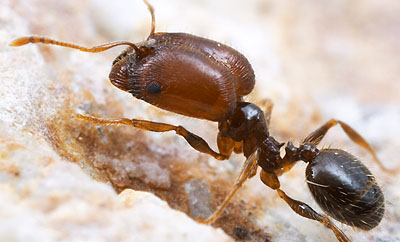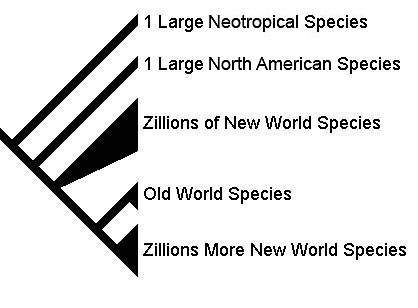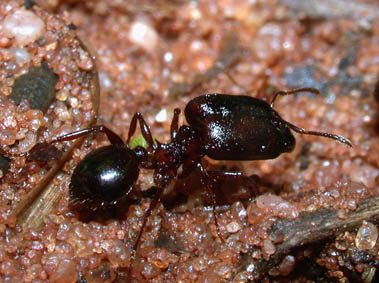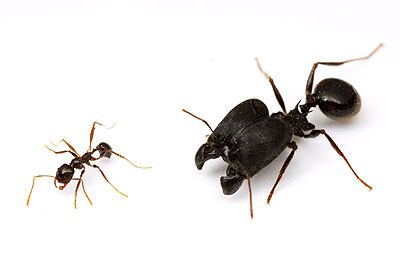
After reading a couple times through Corrie Moreau's hot-off-the-press Pheidole evolution paper, I am pleased to give it a thumbs-up. The paper is behind a subscription barrier, so I have distilled the results into an informal summary:

Pheidole is one of the most important groups of ants. They are distinctive in always having at least two sharply-defined types of worker ants in the nest: minor workers that just sort of look like normal little ants, and the very front-heavy major workers with an enormous head and powerful jaws. Pheidole is found in warmer climates around the world, in huge numbers, where they do all sorts of things like harvesting seeds or inhabiting ant-plants. There may be more species of Pheidole on earth than in any other genus of ant (except for Camponotus, maybe).
Here's the story from Corrie's paper:
1. Pheidole arose in the New World about 60 million years ago- that's after the continents split up- and colonized the Old World much later. The extra time in the Americas could explain why they are so diverse here compared with, say, Africa. (We can also say that it's unlikely T. rex ever trod upon a Pheidole).
2. Although Corrie doesn't mention this explicitly, the phylogeny implies that when Pheidole first evolved it was pretty big. Pheidole fimbriata, inferred as sister to the rest of the genus, is a predaceous Neotropical species. The head alone is more than three millimeters long. That doesn't sound like much, but many Pheidole are tiny little things that don't even reach 3mm in total body length. The next most recent split led to a seed-harvester common here in Arizona, Pheidole rhea, the largest North American species and a gargantuan ant compared to its sympatric congeners. The next split produced a clade with ants of varying size, but includes some other biggies like P. militicida. Given the size of all the ancient lineages, a reasonable inference is that the common ancestor of all Pheidole was similarly large.


3. E. O. Wilson, in his 2003 massive revision of the genus, decided that he'd try to simplify the identification process by dividing all the species in a series of smaller subgroups. His decision seems sensible on the surface, but anyone who has tried to figure out how any given ant fits into Wilson's groups can vouch for how non-sensible it turned out. The phylogeny explains why. Wilson's species groups are an unsightly splatter across the tree, only one of them looked like a natural grouping, and some of the other ones appeared to be wholly random.
4. To Wilson's credit, the mess isn't entirely his fault. Corrie also found that at least one key trait- seed-harvesting behavior- seems to come and go throughout the genus at the drop of a hat. If worker morphology evolves readily in response to ecological niche, then disparate lineages may be expected to converge on a similar morphology.
5. Convergence appears to be the case as well for the handful of species that have evolved a third worker caste, the supermajor. This will be a boon to folks studying the evolution of morphological castes- each separate evolution is an independent event, so the more of these there are the more statistical power can be harnessed to test hypotheses about how ant castes evolve.
6. Corrie points out repeatedly- and correctly- that the single biggest obstacle to doing anything with this phylogeny is that we don't know anything about the biology of most of the species. We don't know what they eat, where they nest, when they mate, how big their colonies are. Nothing. So next time you happen to find yourself in the company of Pheidole, take some notes and collect a voucher.
As much as I like this study, the cynic in me can't let Corrie's paper go without at least one criticism. And here it is:
The choice of genes to provide DNA sequence data is pretty weak, and the middle parts of the tree are really hurting because of it.
I can understand the use of COI- that's the standard mitochondrial DNA barcoding gene. The mitochondrion evolves quickly enough to resolve differences among closely related species, capturing variation that slower genes miss. But Corrie's choice of nuclear genes- and this is where the real meat of evolution happens- is really strange. She uses two genes, long-wavelength rhodopsin and histone3. I have worked with both genes- LWR in ants and H3 in beetles- and my experience is that they just don't give much for the money.
H3 is particularly odd. It's short, less than 350 base pairs, so it doesn't have much information in it. It hardly has any amino acid changes, which means that if the synonymous positions saturate then it's got no phylogenetic signal at all. That may not matter for a younger group like Pheidole, but now that standard sequencing reads can go over 900 base pairs, at no extra cost, why waste money on a short stub of a gene with no amino acid variation? EF-1a, CAD, 28S rDNA, Arginine Kinase, RNA polymerase, Enolase, and Wingless have all been developed for Hymenoptera, they all offer more variation, and they are all longer than H3. I do hope the Pheidole group swaps out for some additional genes as the study continues. They'd get a lot more resolution for the cost, especially in that difficult middle part of the tree.
All the same, this is some nice work, and now that the Pheidole working group seems to be rolling I'm looking forward to seeing what else they come up with.
Some links:
Pheidole photos at myrmecos.net
source: Moreau, C. S. 2008. Unraveling the Evolutionary History of the Hyperdiverse Ant Genus Pheidole (Hymenoptera: Formicidae). Molecular Phylogenetics and Evolution, In Press, Accepted Manuscript.

Nice review!
Thanks Scott!